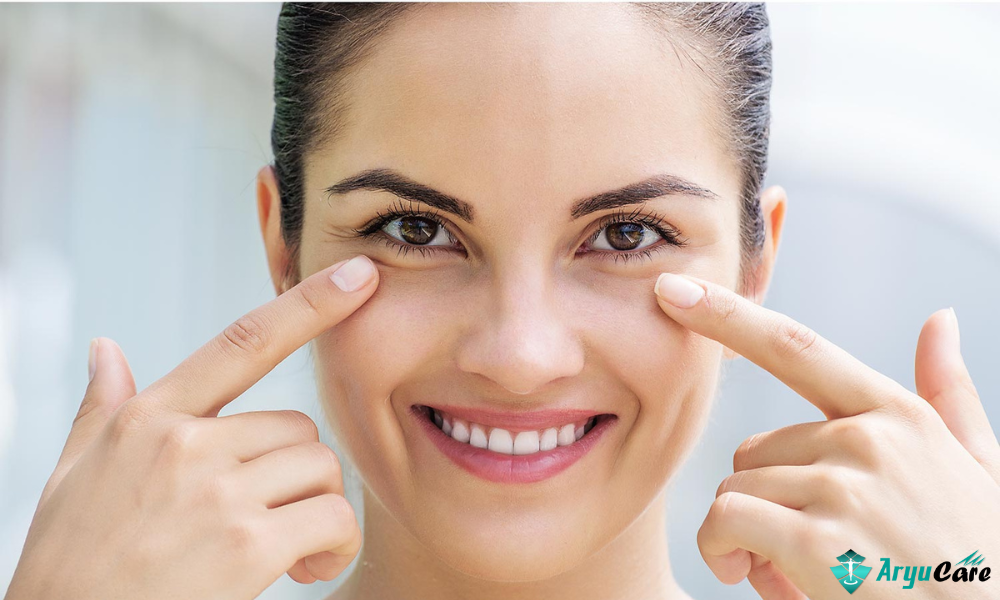Eye Care
Eye Care Tips for Healthy Eyes
Why Eye Care is important ?
With the rush of modern life, the eye health is very important. “Eye to Eye Care” is your ultimate resource for seeing the best and keeping your vision sharp. Let’s get into simple practices that will keep your eyes bright and healthy.
Through preventive eye care, regular eye check-ups are the basis. Schedule yearly visits to your optometrist to detect problems as early as possible. This is an important practice for all age groups since eye disorders can develop at any stage of life.
Eye health is also significantly enhanced by a nutrient rich diet. Foods that are rich in vitamins A, C, and E, as well as zinc, provide your eyes with a diet. Consider green leafy vegetables, colorful vegetables, and fish rich in omega 3.
Fight digital eye strain with the 20-20-20 rule. Every 20 minutes, take a 20-second break, and look at something that is 20 feet away. This simple practice reduces the eye stress caused by long hours of use of the screen.
Protect your eyes from harmful UV rays by purchasing UV-protected sunglasses. The habit of wearing them, particularly when the sun is most intense, helps minimize the incidence of such conditions as cataracts.
The eye health is often neglected in terms of quality sleep. Get 7-9 hours of sleep every night to avoid dry eyes and discomfort.
Stay hydrated to keep the eyes moist. A hydrated body equals hydrated eyes, preventing dryness and irritation.
It may surprise you to know that exercise is good for the eyes. Physical activity enhances blood circulation thereby reducing the occurrence of age-related macular degeneration.
For those spending many hours in front of a computer, avoid eye strain by ensuring that the workplace is well-lit, adjusting the screen brightness, and seating in an ergonomic chair to maintain proper posture.
Develop good eye care habits in children from a young age. Promote outdoor activities, minimize screen time, and ensure proper nutrition. Routine eye exams for children are also important.

What are the 4 Ps of Eye Care?
The 4 Ps of eye care encapsulate key principles for maintaining optimal eye health: Prevent, protect, proper nutrition, and periodic check-ups.
First line of defense is prevention. Protect your eyes from potential hazards, including harmful UV rays, overexposure to screens, and environmental pollutants. Preventive measures help to minimize the risk of eye-related problems.
Protection highlights the need to protect your eyes. Purchase high-quality sunglasses that provide UV protection to protect your eyes from the damaging effects of the sun. Furthermore, the use of safety goggles should be considered in areas where eye injuries are prevalent, for example, during sports activities or construction work.
Proper Nutrition is a basic foundation of eye care. Make sure your diet is high in vitamins A, C, and E, and minerals such as zinc. Besides this, these nutrients help keep your eyes healthy and prevent age-related eye diseases.
Regular eye check-ups are important for ensuring eye health. Visits to an optometrist help to detect problems early and prevent them from progressing into more serious complications. Despite the apparent lack of issues, regular eye examinations are necessary for complete eye care.
These 4 Ps should be incorporated into your daily routine in order to build a strong basis for maintaining a healthy eye throughout life. Prevention, protection, good nutrition, and periodic check-ups enable you to have a clear sight and preserve the good health of your eye.
What is the 20-20-20 rule?
The 20-20-20 rule is a simple and practical method that helps to relieve tired eyes and eyes strain from digital device use. The rule is not complicated and recommends to take breaks from time to time to allow your eyes to rest.
Here’s how it works: every 20 minutes, take a break and look at something that is 20 feet away for no less than 20 seconds. This intentional break gives the eye muscles a chance to rest and also helps fight the eye strain brought about by long hours of looking at a screen.
The constant use of a computer, tablet, or smartphone screen can contribute to the development of digital eye strain or computer vision syndrome. Symptoms include eye tiredness, dryness, vision changes, and headaches. The 20-20-20 rule is a practical cure because it gives your eyes a moment’s pause to refocus on a distant object, thus relieving the strain caused by the close-up screen viewing.
Implementing the 20-20-20 rule into your daily routine is a preventive measure of keeping your eyes healthy, especially for those who spend much of their time working or interacting with digital devices. If you observe this rule and take regular breaks, you can help to preserve comfortable and healthy eyes in our modern world of technology.
What helps to improve eyesight?
Perfecting vision requires embracing different practices that enhance the general health of the eyes. While individual results may vary, incorporating the following habits into your routine can contribute to maintaining and potentially enhancing your vision:
Nutrient-Rich Diet
Eat foods that are high in vitamins A, C, and E, as well as minerals like zinc and omega-3 fatty acids. Good options include leafy greens, colorful vegetables, fruits, and fish, which promote good eye health.
Stay Hydrated
Good hydration is necessary for the overall health of the body and for the eyes. Consuming an appropriate amount of water prevents dry eyes and preserves the moisture of the eyes.
Regular Exercise
Take part in regular physical activity to stimulate the blood circulation that is good not only for your body but also for your eyes. The risk of age-related macular degeneration is minimized by physical activity.
Protective Eyewear
Wear sunglasses that protect against UV to protect your eyes from harmful ultraviolet rays. This prevents conditions such as cataracts and protects the delicate structures of the eyes.
Follow the 20-20-20 Rule
To alleviate digital eye strain, particularly for individuals who work on their screens for many hours, follow the 20-20-20 rule. After every 20 minutes take a 20 seconds break and look at something 20 feet away.
Adequate Sleep
Make sure you get 7-9 hours of good sleep every night. Sleep deprivation can lead to eye irritation, dryness, and other vision-related problems.
Regular Eye Check-ups
Have annual eye checkups with an optometrist. Regular check-ups can also help catch problems early, allowing time for early intervention that can prevent serious complications.
Limit Screen Time
Cut down on extended use of digital screens, and keep the screen at a comfortable distance to prevent eye fatigue.
Eye Exercises
Practice simple eye exercises to improve focus and strengthen eye muscles. This can include activities like eye rolls, focusing on near and far objects, and palming.
Manage Stress
Chronic stress can impact eye health. Incorporate stress management techniques such as meditation, deep breathing, or yoga into your routine.
What is 6 4 vision?
The term ‘6/4 vision’ is an optometric measurement of visual acuity. Visual acuity is the measure of how clear or sharp a person’s vision is, especially at the standard distance for testing. The symbol 6/4 stands for an abnormal level of visual sharpness.
In a Snellen eye chart, the first number (6) is the distance of testing, measured in feet. The second number (4) refers to the point where a person with normal vision should be able to read the same line on the chart. Therefore, if someone has 6/4 vision, it means that he can see at 6 feet what a person with normal vision can see only at 4 feet.
A person with 6/4 vision is considered above average and has better vision than the normal. People with this level of vision can see details better at a greater distance than people with normal vision or 20/20 vision.
Visual acuity is an important aspect of eye health, but it is not the only indicator; peripheral vision, depth perception, and eye health conditions are other factors that contribute to overall vision assessment. Annual eye examinations with an optometrist will include a full report of your eye health and visual acuity.
What are the three types of eye protection?
Eye protection is essential in many settings in order to avoid injuries and ensure proper eye health.There are three main types of eye protection commonly used:
Safety Glasses
Safety glasses are essential eye protection and are made to shield against flying debris, particles, or objects. They find application in the construction industries, woodwork, manufacturing, and laboratory. Safety glasses may be equipped with side shields for extra protection.
Goggles
Goggles provide a more complete seal around the eyes, thereby offering protection from a broader spectrum of risks. They are commonly employed where there is a danger of chemical splashes, dust, or other airborne materials. Goggles are widely used in laboratories, the medical field, and in some types of sports.
Face Shields
Face shields protect the entire face, including the eyes, nose, and mouth. They are clear and reach from the forehead downward to the face. In health facilities especially during medical operations where there is fluid splashes, face shields are widely used. They are also used in some industrial fields where full-face protection is required.
The choice of the most appropriate eye protection is determined by the type of hazards present in an environment. It is also significant to adhere to safety standards and regulations to make sure that the chosen eye protection is able to protect from the possible hazards. From time to time, workplace or activity hazard assessments may reveal the best type of eye protection for a specific situation.
Trending Products:
24 Carat Gold Eye Contour Gel 20 gm | 9 PM Eye Drop – 2.5ml (0.005%) | Albalon Eye Drop | Almond Under Eye Cream 20 gm | AZELAST Eye Drops 5ml | Azopt Eye Drop – 1% (5 ml) Eye Drop | BIMAT Eye Drops 3ml | Bimat With Brush Eye Drop | dorzox t eye drop | Epina Eye Drop | Fml Eye Drop | Just Tears Eye Drop | Herbal Kajal 3 Gm – 3 Gm | Lacoma Pf Eye Drop





Wow, this article really opened my eyes (pun intended) to the importance of eye care! I never realized how much we take our vision for granted until reading this. Thank you for the insightful information.
Wow, these eye care tips are incredibly helpful! I never knew that certain foods could actually improve my vision. Will definitely be incorporating more leafy greens into my diet now.
I never realized the importance of proper lighting until reading this article. I’ll definitely be investing in some adjustable desk lamps to reduce eye strain. Great suggestion!
Wow, these tips are like eye candy for my peepers! Gotta try that 20-20-20 rule; maybe then I won’t squint at my screen like a confused owl! 🦉👓
Thanks for sharing these eye care tips! As someone who spends a lot of time in front of screens, it’s important to take care of our eyes. I’ll definitely be incorporating some of these tips into my daily routine.
Thank you for stressing the importance of regular eye exams. It’s easy to forget about until there’s a problem. Perhaps you could explore common eye conditions and their symptoms in another post?
I’ve heard about the 20-20-20 rule before, but I always forget to actually do it. I’m going to set a reminder on my phone to make sure I take breaks from my screen.
Great tips! I never realized how important it is to wear sunglasses for eye protection. Will definitely be more mindful now.
Thanks for sharing these eye care tips! Taking care of our eyes is so important, and these simple tips make it easy to maintain healthy vision. Great article!
Great tips for healthy eyes! It’s so important to take care of our vision. Your advice on regular eye check-ups and protecting our eyes from the sun is really valuable. Thanks for sharing these tips!
I never realized that smoking could increase the risk of developing cataracts. That’s definitely another reason to kick the habit for good. Thanks for sharing this important information!
Thanks for sharing these eye care tips! It’s so important to take care of our eyes, especially in today’s screen-filled world. I’ll definitely try incorporating these into my daily routine. Keep up the great content! 🌟
These eye care tips are so practical and easy to follow. I never realized how important it is to take breaks from screens—I’ll definitely be setting reminders from now on. Thanks for the helpful reminders to keep our eyes healthy!
Love these tips! Keeping our eyes healthy is so important. I never realized how simple habits like taking breaks from screens could make such a big difference. Thanks for the reminders!
Love these reminders! Simple habits like blinking more often can make a big difference in eye comfort.
These eye care tips are spot on! It’s so important to take care of our eyes, especially with all the screen time we have these days. I never realized how simple habits like regular breaks and proper lighting could make such a difference.
Thanks for sharing these eye care tips. I never realized how important simple habits like taking breaks from screens and wearing sunglasses could be for keeping my eyes healthy. Definitely going to start implementing these tips into my daily routine!
Great tips for keeping our eyes healthy! I never realized how important it is to take breaks from screens. Definitely going to try the 20-20-20 rule. Thanks for sharing these helpful insights!
Thanks for sharing these eye care tips. I never realized how important regular breaks from screens are until I read this. Definitely going to start implementing these tips to keep my eyes healthy!
Eye care reminder: Regular check-ups aren’t scary – they’re your eyes’ way of saying ‘thanks for caring!
Ever wondered about inhaler asthma treatments? They’re like having a wind machine for your lungs – keeping things breezy and carefree.